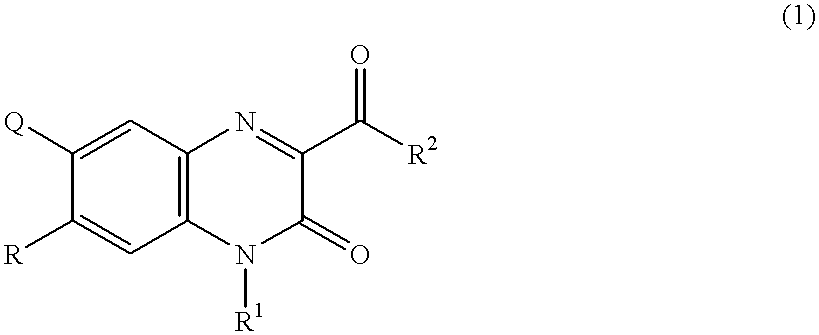6,7-asymmetrically disubstituted quinoxalinecarboxylic acid derivatives, addition salts thereof, and processes for the preparation of both
a technology of quinoxalinecarboxylic acid and quinoxaline, which is applied in the field of 6, 7asymmetrically disubstituted quinoxalinecarboxylic acid derivatives, addition salts thereof, can solve the problems of inability to consider satisfactory compounds, inability to disclose glycine antagonism, and inability to reduce the effect of glycine antagonism
- Summary
- Abstract
- Description
- Claims
- Application Information
AI Technical Summary
Problems solved by technology
Method used
Image
Examples
example 2
Ethyl 3,4-dihydro-7-fluoro-6-nitro-3-oxoquinoxaline-2-carboxylate
##STR86##
Using ethyl 3,4-dihydro-7-fluoro-3-oxoquinoxaline-2-carboxylate (558 mg, 2.36 mmol) and following the same process as in Example 1, 297 mg of the title compound were obtained as yellow powder. Yield 45%.
.sup.1 H-NMR(CDCl.sub.3,.delta.):1.49(3H,t,J=7.0 Hz),4.58(2H,q,J=7.0 Hz), 7.89(1H,d,J=10.6 Hz),8.16(1H,d,J=6.2 Hz).
example 3
Ethyl 7-bromo-3,4-dihydro-6-nitro-3-oxoquinoxaline-2-carboxylate
##STR87##
To a solution of ethyl 7-bromo-3,4-dihydro-3-oxoquinoxaline-2-carboxylate (2.60 g, 8.75 mmol) in acetic acid (35 ml) was added dropwise fuming nitric acid (1.40 ml, 31.5 mmol) at 60.degree. C., and the mixture was stirred for 2 hours at the same temperature. The reaction mixture was poured into water (300 ml). The precipitate was collected by filtration, washed with water, and then air-dried to obtain 2.79 g of the title compound as yellow powder. Yield 93%.
.sup.1 H-NMR(DMSO-d.sub.6,.delta.):1.33(3H,t,J=7.3 Hz),4.40(2H,q,J=7.3 Hz), 7.86(1H,s),8.40(1H,s),13.24(1H,brs).
example 4
Ethyl 3,4-dihydro-7-methyl-6-nitro-3-oxoquinoxaline-2-carboxylate
##STR88##
To a solution of ethyl-3,4-dihydro-7-methyl-3-oxoquinoxaline-2-carboxylate (1.65 g, 7.10 mmol) in acetic acid (15 ml) was added dropwise fuming nitric acid (1.36 ml, 14.2 mmol), and the mixture was stirred for 1 hour at 60.degree. C. The reaction mixture was poured into ice water and, after stirring for 25 minutes, the precipitate was collected by filtration. These were air-dried and then dissolved into ethyl acetate. Moreover, the filtrate was extracted with ethyl acetate, which was combined with foregoing organic layer. After dried over anhydrous sodium sulfate, solvent was distilled off. The residue obtained was purified by means of silica gel column chromatography [n-hexane:ethyl acetate=1:1] to obtain 887 mg of the title compound as pale yellow powder. Yield 45%.
.sup.1 H-NMR(CDCl.sub.3,.delta.):1.48(3H,t,J=7.3 Hz),2.65(3H,s),4.55(2H,q,J=7.3 Hz), 7.91(1H,s),8.02(1H,s),12.42(1H,brs).
PUM
| Property | Measurement | Unit |
|---|---|---|
| pressure | aaaaa | aaaaa |
| pressure | aaaaa | aaaaa |
| temperature | aaaaa | aaaaa |
Abstract
Description
Claims
Application Information
 Login to View More
Login to View More - R&D
- Intellectual Property
- Life Sciences
- Materials
- Tech Scout
- Unparalleled Data Quality
- Higher Quality Content
- 60% Fewer Hallucinations
Browse by: Latest US Patents, China's latest patents, Technical Efficacy Thesaurus, Application Domain, Technology Topic, Popular Technical Reports.
© 2025 PatSnap. All rights reserved.Legal|Privacy policy|Modern Slavery Act Transparency Statement|Sitemap|About US| Contact US: help@patsnap.com



